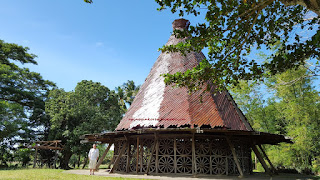(To rephrase a proverb, the road to heaven
is paved with good plantations)
This is the Chapel of the Cartwheels in
Hacienda Santa Rosalia in Manapla (northern part of Negros Occidental, the Philippines) named after the discarded cartwheels that were
used in the hacienda to carry harvested sugarcane but fell into disuse with the
introduction of rubber tires in the mid-20th century.
This chapel is a brainchild (no pun intended) of a Catholic priest, Father Guillermo Ma. Gaston, popularly known as Monsignor GG, one of the eight children of Don Jose Gaston and his wife, Doña Consuelo Azcona-Gaston (Don Jose, being a close friend of the Montinola family in Victorias City, has appeared in two of my previous blogs, one about a photograph taken on Don Felix Montinola's birthday in 1940 and another with President Diosdado Macapagal).
According to Monsignor GG, upon his return from Rome in 1966 where he finished his theological studies, he thought of building a chapel right on the site where his grandparents’ house used to be and using the old, discarded cartwheels kept by his father Don Jose, Monsignor GG turned these as a symbol of Christian faith: the center represents God; the spokes represent Jesus as they point and connect to God at the center with Jesus being ‘the Way to the Father’; and the Holy Spirit, represented by the ring of the wheel, keeps everyone from being lost.
Monsignor GG used a familiar piece of farm device to symbolize the Holy Trinity, one easily recognizable by the workers in the hacienda as mandated to the clergy by Saint Pope John XXIII. Although those cartwheels became useless in the hacienda, they were elevated
into a holy symbol of the hacienda’s chapel.
This chapel is a brainchild (no pun intended) of a Catholic priest, Father Guillermo Ma. Gaston, popularly known as Monsignor GG, one of the eight children of Don Jose Gaston and his wife, Doña Consuelo Azcona-Gaston (Don Jose, being a close friend of the Montinola family in Victorias City, has appeared in two of my previous blogs, one about a photograph taken on Don Felix Montinola's birthday in 1940 and another with President Diosdado Macapagal).
According to Monsignor GG, upon his return from Rome in 1966 where he finished his theological studies, he thought of building a chapel right on the site where his grandparents’ house used to be and using the old, discarded cartwheels kept by his father Don Jose, Monsignor GG turned these as a symbol of Christian faith: the center represents God; the spokes represent Jesus as they point and connect to God at the center with Jesus being ‘the Way to the Father’; and the Holy Spirit, represented by the ring of the wheel, keeps everyone from being lost.
(From a farm device to a divine symbol)
(Monsignor Gigi never imagined that his chapel
would become a popular tourist spot)
But knowing what happened during the retreat of the Japanese soldiers from this northern side of the Negros island
in 1945, I believe the Chapel of the Cartwheels is not just a symbol of
thanksgiving by one family for the blessings bestowed on them but also a thanksgiving
for the many hacienda lives saved during the war.
Realizing they were losing the war, the Japanese soldiers burned down villages and towns on this part
of Negros as they retreated. And one early morning at around 4, while it was still dark, the Gaston family
was awakened by a big fire at Manapla town that was just three kilometers east
of the hacienda; the big fire was visible from the rooftop of the mansion. Word
reached the family that the Gamboa Mansion, located near the main road just
outside Manapla, was already being torched and one worker sent by the family to
find out came back and told Don Jose and his family the scariest words
they heard that day, “Daw kamo na guid
ang dason”, or “It looks like you're next”.
After hearing this, Don Jose, a devotee of
the Sacred Heart, led his family to pray and surrendered everything to God. The
family then abandoned their home and fled towards the coast. The Japanese military, during their occupation, had mapped the island and knew exactly where these mansions were located, and after torching the Gamboa Mansion, Japanese soldiers made their way to Hacienda Sta. Rosalia in two trucks to burn down the Gaston Mansion and kill anyone who
resisted. But suddenly, from the dark skies above that was just about to welcome a new morning the Gastons had expected to be full of terror and loss, an American night-fighter
plane, the Northrop P61, miraculously appeared and strafed the Japanese trucks, causing the
Japanese to turn around and leave the hacienda alone.
(The mansion is surrounded by fruit-bearing
trees and cooled by Amihan breezes)
Monsignor GG was just 14 then, and yet
these memories and his family’s faith were more than a reason to build the
Chapel. For me, hearing the story from Monsignor GG himself and realizing
what faith and devotion can do for a family and for a people, the Chapel of the
Cartwheels is more than just one family’s thanksgiving.
In case you have the chance, do visit the place and find out what it is to you. 🙏
In case you have the chance, do visit the place and find out what it is to you. 🙏






No comments:
Post a Comment